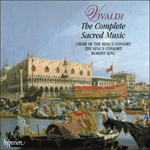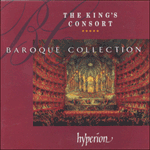
Welcome to Hyperion Records, an independent British classical label devoted to presenting high-quality recordings of music of all styles and from all periods from the twelfth century to the twenty-first.
Hyperion offers both CDs, and downloads in a number of formats. The site is also available in several languages.
Please use the dropdown buttons to set your preferred options, or use the checkbox to accept the defaults.

It is slightly embarrassing to have to admit that no fewer than three of the movements of RV595 are closely based on material borrowed from other men. Vivaldi’s personal collection of sacred vocal music by other composers, today found alongside his own compositions in the National Library in Turin, provided an irresistible temptation for him whenever he decided, or felt obliged, to include a movement in the strict (or neo-Palestrinian) style for which he had little training or, perhaps, inclination. He must have been very wary of being found out: I deduce this from the fact that his two known borrowings from a printed source—the collection of Duetti, terzetti e madrigali a più voci published in 1705 by his fellow Venetian Antonio Lotti (an organist at the ducal church of S. Marco who later rose to become its primo maestro)—are much more heavily disguised than those of the manuscripts, mostly unattributed, in his own possession. Fortunately, Vivaldi, like Handel, was usually able to make improvements to the material he appropriated, and this is true of all three borrowings in RV595.
Dixit Dominus, Psalm 109 (110 in Protestant Bibles), is invariably the first of the five Psalms sung at Vespers on Sundays or feast days. This explains both the frequency of its setting and its tendency to festive grandiloquence. In his orchestra Vivaldi includes a trumpet in D (the keynote of the work) and a pair of oboes, exactly as in the ‘second’ Gloria, RV588, which may be contemporary with it. The Psalm gets off to a dazzling start—the pointillistic orchestration of its opening chorus (listen especially to the wind instruments) is complemented by incisive rhythms and some delicious word-painting for ‘sede’ (‘sit thou’)—in the five-part choral writing. As in his ‘other’ Dixit Dominus and both of his Gloria settings, Vivaldi casts his second movement as a patiently unfolding, slow chorus in B minor; the pedal-note at its climax supports some of the most affecting harmonies he ever wrote. A cheerful ‘Virgam virtutis’ for solo soprano in G major is succeeded by an even livelier ‘Tecum principium’ with novelty instrumentation (so beloved at the Pietà): here two solo cellos partner a pair of sopranos above. The fifth movement, bipartite, opens with a severe ‘Juravit Dominus’ for chorus (where the alto acts like a cantor, to whom the other three voices respond), followed by a very brief ‘Tu es sacerdos’; the latter is a borrowing, with small improvements, from an anonymous Dixit Dominus dated 1708 (RVAnh.27). The first soprano then has another solo (‘Dominus a dextris tuis’), before an evocation of the last trump appears in the ‘Judicabit’, giving way to a suitably agitated ‘implebit ruinas’. The ‘De torrente’ provides a lyrical interlude for solo alto, where unison violins conjure up the lapping motion of a brook. Now the Doxology begins. First we have a charming choral terzet for alto, tenor and bass, almost in the style of seventeenth-century bel canto. This is a cunning paraphrase of the martial opening section of Lotti’s Inganni dell’umanità from the collection already mentioned. The terzet leads straight into the ‘Sicut erat in principio’, which, acting out a familiar musical pun, is an abridged restatement of the opening movement. The triumphant concluding fugue on ‘Et in saecula saeculorum’ is a rescored and cleverly expanded version of its counterpart in an anonymous Laudate pueri Dominum, RVAnh.29, which dates right back to 1690.
from notes by Michael Talbot © 1997
Il est légèrement délicat de devoir admettre que pas moins de trois mouvements du RV595 reposent étroitement sur un matériau emprunté à d’autres musiciens. Vivaldi possédait une collection de musique vocale sacrée d’autres compositeurs (aujourd’hui à la Bibliothèque Nationale de Turin, avec ses propres compositions), qui le tenta irrésistiblement à chaque fois qu’il décida, ou se sentit obligé, d’inclure un mouvement dans le style strict (ou néo-palestrinien), pour lequel il avait peu de formation ou, peut-être, peu de goût. Il a dû vraiment redouter d’être découvert, car les deux exemples connus d’emprunts à une source imprimée—le recueil des Duetti, terzetti e madrigali a più voci, publié en 1705 par son compatriote vénitien Antonio Lotti (organiste à l’église ducale de S. Marco, dont il réussit à devenir le primo maestro)—sont bien mieux dissimulés que ceux faits à des manuscrits, le plus souvent non attribués, en sa possession. Par bonheur, à l’instar de Haendel, Vivaldi put généralement améliorer le matériau qu’il s’appropria, et ceci vaut pour les trois emprunts du RV595.
Dixit Dominus, le psaume 109 (110 des Bibles protestantes), est invariablement le premier des cinq psaumes chantés lors des vêpres dominicales ou des jours de fêtes; ce qui explique tant la fréquence de sa mise en musique que sa tendance à la grandiloquence festive. Dans son orchestre, Vivaldi inclut une trompette en ré (la fondamentale de l’œuvre) et deux hautbois, exactement comme dans le «second» Gloria, RV588, peut-être contemporain. Le psaume prend un départ éblouissant—l’orchestration pointilliste de son chœur d’ouverture (écoutez, en particulier, les instruments à vent) étant complétée par des rythmes incisifs et un madrigalisme délicieux pour «sede» («assieds-toi»)—dans l’écriture chorale à cinq parties. Comme dans son «autre» Dixit Dominus et dans ses deux mises en musique du Gloria, Vivaldi fait de son deuxième mouvement un chœur lent en si mineur, qui se déploie patiemment; la pédale à son apogée soutient quelques-unes des plus émouvantes harmonies vivaldiennes. Un joyeux «Virgam virtutis» pour soprano solo, en sol majeur, précède un «Tecum principium» encore plus animé, avec une instrumentation nouvelle (tellement aimée à la Pietà), dans laquelle deux violoncelles solistes accompagnent deux sopranos, au-dessus. Le cinquième mouvement, bipartite, s’ouvre sur un sévère «Juravit Dominus» pour chœur (où l’alto agit comme un cantor, auquel les trois autres voix répondent), suivi d’un très bref «Tu es sacerdos», emprunté, avec de petites améliorations, à un Dixit Dominus anonyme, daté de 1708 (RVAnh.27). La première voix de soprano a ensuite un autre solo («Dominus a dextris tuis»), avant une évocation de la trompette du Jugement dernier dans le «Judicabit», qui cède la place à un «implebit ruinas», animé. Le «De torrente» offre un interlude lyrique pour alto solo, où les violons à l’unisson évoquent le clapotis d’un ruisseau. La doxologie débute alors, avec un charmant terzet pour alto, ténor et basse, presque dans le style du bel canto du XVIIe siècle. Il s’agit d’une astucieuse paraphrase de la section d’ouverture martiale de l’Inganni dell’umanita de Lotti, extrait du recueil susmentionné. Le terzet mène directement au «Sicut erat in principio» qui, exprimant une paronymie musicale familière, est une ré-énonciation abrégée du mouvement d’ouverture. La fugue conclusive triomphante sur «Et in saecula saeculorum» est une version récrite et intelligemment développée d’un passage équivalent contenu dans un Laudate pueri Dominum anonyme, RVAnh.29, qui remonte à 1690.
extrait des notes rédigées par Michael Talbot © 1997
Français: Hyperion Records Ltd
Es ist ein wenig beschämend, eingestehen zu müssen, daß insgesamt drei Sätze des RV595 sehr stark auf entliehenem Material aufgebaut sind. Vivaldis persönliche Sammlung an geistlicher Musik aus der Feder anderer Komponisten—Werke, die heute neben seinen eigenen Kompositionen in der Nationalbibliothek von Turin aufbewahrt werden—stellten eine unwiderstehliche Versuchung für ihn dar, wann immer er sich dazu entschloß oder sich verpflichtet fühlte, einen Satz im strengen (oder Neo-) Palestrina-Stil einzufügen—einem Stil, in dem er wenig geschult war oder für den er vielleicht nur wenig übrig hatte. Er muß allerdings sehr darauf bedacht gewesen sein, nicht entdeckt zu werden: Ich schlußfolgere dies aus der Tatsache, daß seine zwei bekannten Anleihen aus einem veröffentlichten Werk—der 1705 erschienenen Sammlung Duetti, terzetti e madrigali a più voci von seinem venezianischen Mitbürger Antonio Lotti (einem Organisten an der herzoglichen Kirche von San Marco, der später zum primo maestro aufstieg)—wesentlich stärker getarnt und verschleiert waren als die Anleihen aus den meist anonymen Manuskripten, die sich in seinem eigenen Besitz befanden. Vivaldi war jedoch, ebenso wie Händel, für gewöhnlich in der Lage, das sich zu eigen gemachte Material zu verbessern. Dies ist auch der Fall bei den drei Entlehnungen in RV595.
Dixit Dominus, Psalm 109 (bzw. 110 in der evangelischen Bibel), ist nach wie vor der erste der fünf Psalmen, die bei Vespern an Sonn- oder Feiertagen gesungen werden. Dies erklärt sowohl die Fülle von Vertonungen dieses Psalms als auch ihren übertrieben feierlichen Pathos. Vivaldis Orchesterbesetzung für dieses Stück—ebenso wie für das „zweite“, möglicherweise zeitgleich entstandene Gloria, RV588—schließt eine D-Trompete (der Grundton dieses Werkes) und zwei Oboen ein. Der Beginn des Psalms ist schlichtweg brillant: Die pointillistische Instrumentierung des Eröffnungschores (achten Sie einmal besonders auf die Bläser) wird durch prägnante Rhythmen und einige hervorragende Tonmalereien für „sede“ („setze Dich“)—in der fünfstimmigen Chorpartitur—vervollkommnet. Wie auch im Falle der „anderen“ Dixit Dominus-Vertonung sowie beider Gloria-Vertonungen gestaltet Vivaldi den zweiten Satz als einen sich peu à peu entfaltenden, langsamen Chor in h-Moll. Auf den Orgelpunkt beim Satzhöhepunkt stützen sich einige der anrührendsten Harmonien, die Vivaldis Schöpfergeist je entsprungen sind. Einem fröhlichen „Virgam virtutis“ für Solosopran in G-Dur schließt sich ein noch lebhafteres „Tecum principium“ mit neuartiger Instrumentierung an (so beliebt am Ospedale della Pietà): Zwei Solocelli paaren sich hier mit zwei hohen Sopranen. Der fünfte (zweiteilige) Satz beginnt mit einem strengen „Juravit Dominus“ für den Chor (dessen Altstimme die Rolle des Kantors übernimmt, während die anderen drei Stimmen antworten), gefolgt von einem äußerst kurzen „Tu es sacerdos“, das eine „leicht aufgebesserte“ Entlehnung aus einem anonymen Dixit Dominus von 1708 ist (RVAnh.27). Der erste Sopran übernimmt dann einen weiteren Solopart („Dominus a dextris tuis“), bevor der Klang der Posaunen des Jüngsten Gerichtes in „Judicabit“ evoziert wird, der daraufhin einem angemessen bewegten „implebit ruinas“ weicht. Die Soloaltstimme bestreitet nun ein lyrisches Zwischenspiel in „De torrente“, in dem durch die Unisono-Violinen die Vorstellung eines plätschernden Baches erweckt wird. Nun beginnt die Doxologie. Zuerst erklingt ein reizendes Terzett für Alt, Tenor und Baß, fast im Stil eines Belcanto aus dem 17. Jahrhundert. Es handelt sich hier um eine geschickte Paraphrase des militärischen Eröffnungsteils von Lottis Inganni dell’umanita aus der bereits erwähnten Sammlung. Das Terzett leitet direkt zu „Sicut erat in principo“ über, das sich mit einem bekannten musikalischen Wortspiel vergnügt und eine gekürzte Wiedergabe des Anfangssatzes darstellt. Die triumphale abschließende Fuge auf „Et in saecula saeculorum“ ist eine uminstrumentierte und schlau erweiterte Version ihres Pendants in einem anonymen Laudate pueri Dominum, RVAnh.29, aus dem Jahre 1690.
aus dem Begleittext von Michael Talbot © 1997
Deutsch: Manuela Hübner
 Vivaldi: The Complete Sacred Music Vivaldi: The Complete Sacred Music‘For King's sterling service to the Vivaldian cause, one of his most important recording and satisfying projects to date, I am thankful’ (Gramophone) ‘If you're waiting for the perfect collection of Vivaldi's sacred music, this is it. It was a happy day when this beautiful boxed set arrived in my m ...» More |
 The King's Consort Baroque Collection The King's Consort Baroque Collection'Hyperion and the Consort celebrate a decade together – fifty CDs – with an anthology of delights. Consistency of performance and of engineering is a ... 'I must admit to being quite bowled over by this record. There is something especially infectious about Robert King's music-making [and] the recording ...» More |

